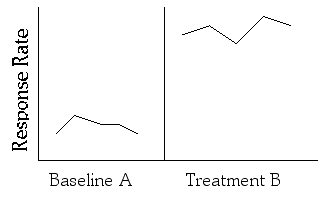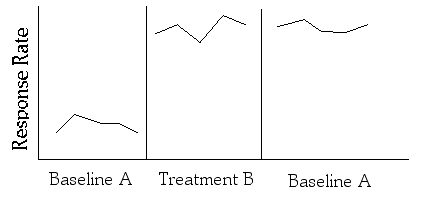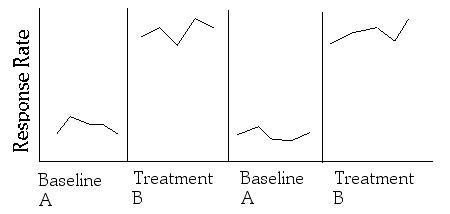
Small N Designs
I. Research designs using small numbers of subjects.
II. When to use a small N design
1.
2.
3.
III. Logic of a Single Subject Design
A.
B.
IV. Criticisms of Large N designs
A.
B.
3 Necessary Elements
1.
e.g.
2.
e.g.
3.
e.g.
D. A-B design- simplest form of small N design
1. A = 1st experimental phase (baseline)
2. B = 2nd experimental phase (treatment)

3. But...
E. Withdrawal Design
1.
2. A-B-A design
a.

F. A-B-A-B design is even better!!
a.
b.

G. A-B-C-B designs
1.
e.g. autistics - reinforcing napkin wiping behavior
2. Treatment B phase
3. Treatment C phase
4.
Problems with Withdrawal Designs:
A.
B.
V. Multiple Baseline Designs
A.
B.
C. Treatment is begun at different times - 3 types
1.
e.g. physical therapy program to help brain injured people regain the ability to walk.
2.
e.g. autistics - program to reduce problem behaviors at dinner.
Take baseline measures of all these behaviors.
1st use treatment only on napkin wipes, and see if behavior changes
2nd add treatment to # times a knife and fork are used
3rd add treatment to # times food is thrown
4th add treatment to amount of food eaten
3.
e.g. autistics - program to reduce problem eating behavior is general
A.
B.
VI Alternating Treatments Design
A.
1.
2.
VII. Changing Criterion Designs
1.
2.
e.g. regular exercising at a certain level for overweight people
3.
4. Once reached, the criterion is made more stringent
e.g. DeLuca and Holborn (1992) - program to help overweight 11-year-old boys start exercising.
1.
2.
3.
VIII Criticisms of Single-Subject Designs
A.
B.
1.
2.
3.
C.
D.